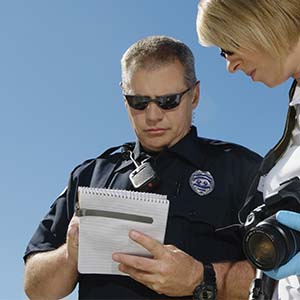Three Common Mistakes People Make That Can Ruin A Personal Injury Case

As former insurance defense attorneys, we know the strategies claims adjusters and defense attorneys use to minimize damages. The following are three of the more common mistakes made by crash victims the defense industry uses to defeat injury claims.
Common Mistake #1 — Not Calling the Police
In our experience, every victim of a car crash should report a car accident to the police. Even if an accident victim fails to call the police to the scene, they should go down to the station and report the accident and the fact they were hurt as soon as possible. Many people have been told not to call the police unless there are serious injuries or blood.
We have heard countless stories from clients that they called 911 only to be told by a dispatcher that the police would not be dispatched to the scene unless someone was seriously injured. Why is calling the police important even if there are no apparent injuries? For several important reasons. A police officer can often resolve a dispute over what happened. In many traffic collisions, the drivers dispute fault, especially in intersection crashes involving the color of the traffic signal.

Although most people are decent and honorable, a few refuse to take responsibility for their actions, mainly when they have caused significant harm or damage to another. They will find any excuse to avoid paying for the damages they caused.
One of the things a police officer does when called to the scene is take statements from the parties and witnesses. Officers are trained interrogators and know what questions to ask. Also, because they are in a position of authority, those they interview are more compelled to tell the truth. Thus, there is a greater likelihood the truth will surface, and the wrongdoer will admit fault.
An officer will typically conduct a scene investigation, including looking for physical evidence, such as skidmarks and vehicle debris. Often, the officer can piece together what happened from the physical evidence. For example, if there is a dispute over who ran the red light, an officer will look at skid marks on the pavement. A person with the green light is less likely to lay down skidmarks unless trying to avoid the collision. More likely, the person who went into a skid was engaged in a panic stop knowing the signal had changed and they could not make it across the intersection.
A common defense tactic is to argue that the absence of police means there were no injuries. The assumption is that if the parties did not bother to call the police, the crash must not have been that big of a deal. In our experience, every collision has the potential to be a big deal. Many people don’t experience the effects of the crash until after leaving the scene.
A collision is a stressful event. Those involved commonly focus on other things at the accident location, such as exchanging information or determining who was at fault, not on whether they are hurt. Injuries are often recognized hours and sometimes days after a crash. We believe the parties should call the police in every collision, big and small, to document the accident. A documented accident in a police report removes the defense tactic that the crash was not a big deal.
Also, documented injuries in a police report add credibility to an injury claim. A common defense tactic used by the insurance company is to argue a claimed injury is unrelated to the collision. The longer an accident victim waits to report an injury, the stronger the defense argument. For example, suppose a victim fails to see a doctor to report a neck injury for almost a month.
In that case, the insurance company will argue the complaint is related to something else, such as arthritis, or that the victim is trying to manufacture a claim. Thus, it is essential to report an injury as soon as possible after a crash. One of the first things claims adjuster will look for is injury documentation close in time to the collision. The adjuster will typically look at the police report for documented injuries. A police report writing an injury is compelling evidence an injury occurred and is instrumental in defeating the defense strategy that no one was hurt.
Common Mistake #2 — Delaying Treatment

Common sense tells us that not all pain requires a trip to the doctor. In our experience, it is not uncommon for an accident victim to defer treatment, hoping the pain will go away. Every person has a specific pain tolerance. Some people can tolerate a lot of pain, and others not so much.
Deferring treatment hoping the pain will subside or resolve, is not unreasonable. Also, going to the doctor is time-consuming and expensive. Often, people have to take time off from work. An appointment typically takes at least a half-day, including driving and waiting to be seen by the doctor. Delaying treatment does not mean a person is not hurt. Nevertheless, insurance adjusters look for delayed treatment to argue that a delay means no or minor injury.
A car crash victim should never ignore pain. In our experience, accident victims should always get checked out. Many people assume their pain is from a minor muscle strain and will go away over time. Often, the pain is due to significant trauma to the spine.
The neck or cervical spine consists of many intricate structures. The spine bones are called the vertebrae and are analogous to blocks stacked on top of each over. There are seven cervical vertebrae or bones. In between each bone is a “disc,” which is like a jelly donut. The donut acts as a shock absorber between the bones. The bones are held together with a network of muscles and ligaments.
Trauma to the neck can damage the different parts of the spine. For example, a rapid movement to the neck from a collision can damage a disc. The disc can change shape and start to bulge. It can also tear, and the inside or jelly can begin to leak out. A protrusion or leaking disc, caused when the disc is damaged, can irritate nearby nerves and cause neck pain and pain down the arms, called radiating pain.
Trauma can also stretch the ligaments that hold the spine together. The ligaments can tear, either partially or wholly. Ligaments are slow to heal because there is not a lot of blood supply. An overly stretched ligament that does not heal may not hold the spine bones in place. A vertebra (bone) out of alignment can irritate nearby nerves contributing to neck pain. Accordingly, an accident victim should never assume an injury is minor.
Spine injuries may require different types of treatment. Often, the doctor will prescribe physical therapy to promote healing and help manage the pain. The doctor will sometimes recommend spine injections when therapy does not resolve the problem. The injections, done under local or general anesthesia, are used to treat the inflammation in the spine. A specialist will recommend surgery as a last resort to resolve the pain or treat the instability of the spine.
Crash victims should never assume an injury is minor. They should not ignore the pain from a collision and should get checked out.
Common Mistake #3 — Exaggerating Injuries

Many crash victims erroneously believe that their recovery depends on what they say about their injuries. A common defense strategy is to check a victim’s social media for postings after an accident. It is not uncommon for a victim to post an activity that contradicts their injury claim.
For example, a victim may claim that their lower back is severe and prevents them from sitting for long periods. The victim will post a picture of their vacation in Europe. The insurance company will use the posting against the victim, arguing the victim could not have suffered a severe injury if they could endure a 12-hour plane ride. The contradiction can ruin a case.
Not all injuries prevent a victim from doing activities. Injuries commonly interfere with a crash victim’s ability to enjoy the experience of doing their activities. For example, most people understand that an annoying backache takes away the experience and pleasure of doing routine activities such as sleeping or watching television.
A constant ache forces victims to make choices to do or not to do something. The victim makes decisions to balance and manage the level of pain at any given time. A nagging ache removes the victim’s freedom to fully enjoy and experience those things they want to do.
There is no need to inflate the effects of an injury. Juries understand what it is like to have a nagging pain, like a distracting toothache. They know how a toothache can ruin an entire day. They appreciate that, unlike a temporary toothache, a permanent injury can affect a person’s life quality for the rest of their life. Accordingly, there is never a reason to inflate an injury claim.
An injury victim can ruin their case by exaggerating an injury.
Have you been injured in an accident and want to know what steps you should take? Contact Mark Cunningham or Ike Sherman at MCIS Lawyers today for a free consultation.
